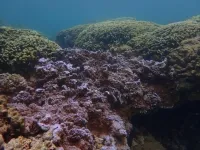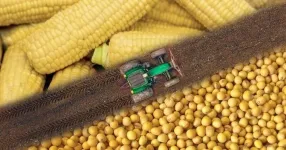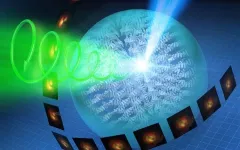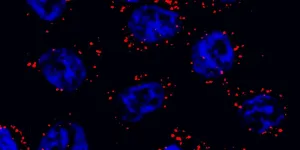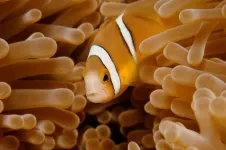INFORMATION:
The Smithsonian's National Zoo and Conservation Biology Institute leads the Smithsonian's global effort to save species, better understand ecosystems and train future generations of conservationists. As Washington, D.C.'s favorite destination for families, the Zoo connects visitors to amazing animals and the people working to save them. In Front Royal, Virginia, across the United States and in more than 30 countries worldwide, Smithsonian Conservation Biology Institute scientists and animal care experts tackle some of today's most complex conservation challenges by applying and sharing what they learn about animal behavior and reproduction, ecology, genetics, migration and conservation sustainability to save wildlife and habitats.
Corals' natural 'sunscreen' may help them weather climate change
2021-06-09
(Press-News.org) Smithsonian Conservation Biology Institute scientists are one step closer to understanding why some corals can weather climate change better than others, and the secret could be in a specific protein that produces a natural sunscreen. As their name implies, Hawaiian blue rice corals sport a deep blue pigment, which is created by chromoprotein and filters out harmful ultraviolet (UV) radiation from the sun. Although UV damage may produce long-term impacts to reproduction in many coral species--including brown rice coral--it may not have the same effect on blue rice coral. The findings of this study were published June 9 in the paper "Reproductive plasticity of Hawaiian Montipora corals following thermal stress" in Scientific Reports.
"Having witnessed firsthand the devastating effects bleaching had on brown rice coral in 2014 and 2015, it is encouraging to see blue rice coral either recovered quickly after bleaching or was not affected by elevated ocean temperatures at all," said Mike Henley, Smithsonian Conservation Biology Institute scientist and the paper's lead author. "By studying blue rice corals' reproductive successes, we can better understand how other corals weather climate change and ocean warming."
A coral's color is derived from a microscopic protozoa called zooxanthellae. This algae lives inside the coral tissue and serves as the main food source for shallow, reef-building corals, including brown rice coral and blue rice coral. They have a symbiotic relationship; the coral protects the zooxanthellae, and in turn zooxanthellae provide the coral with food. These algae also produce sunscreen for the coral. Corals are animals and cannot photosynthesize, but zooxanthellae can. The waste product of their photosynthesis are sugars that feed the coral.
When ocean temperatures warm, however, corals become stressed, and there is a breakdown in the symbiosis. Warm temperatures speed up the zooxanthellae's metabolism, causing it to produce a toxic compound. In response, the corals expel the algae and their sunscreen, leaving them open to harmful UV damage. Since these species get most of their coloring from the zooxanthellae, the expulsion causes the corals to "bleach," or appear lighter in appearance--changing from dark hue to a paler hue.
Bleaching affects some corals' ability to reproduce successfully. Upon expelling their zooxanthellae and, therefore, losing their UV protection, corals' DNA is at greater risk of being damaged. Specifically, changes in their sperm cells' mitochondria can affect their motility (ability to swim) for the long-term. If unable to successfully reproduce, corals cannot create novel offspring that may have genetic modifications that make them more resistant to warming and help them adapt to changing oceans.
Following the 2014 and 2015 bleaching events in Hawaii, the team observed that blue rice coral had exceptional reproductive vigor at 90% motility. Its brown-pigmented counterparts' motility, on the other hand, was only half this amount. This suggests that even if brown corals survive bleaching and look visually healthy, the damage caused by bleaching and UV exposure could have long-lasting impacts on their ability to successfully reproduce. A key factor in the blue rice coral's ability to reproduce successfully might be its sunscreen pigment, which the coral may retain even if it bleaches. By better understanding the role UV-protective pigments play in mitigating the adverse effects of climate change and warming oceans, scientists can piece together the picture of why some species are better equipped to survive and thrive in a changing environment than others.
ELSE PRESS RELEASES FROM THIS DATE:
The impact of double-cropping
2021-06-09
From 1980 to 2016, grain production in Brazil increased more than fourfold, and the country now stands as the world's largest soybean exporter and the second largest exporter of corn. The two main drivers of this increase in food production were cropland expansion and double-cropping, harvesting two crops, such as corn and soybeans, from the same field in a single year.
While cropland expansion has long been recognized as one of the drivers behind the increase in Brazil's agricultural output, a new study published in Nature Food quantifies for the first time the impact that double-cropping also ...
Origin of fairy circles: Euphorbia hypothesis disproved
2021-06-09
The fairy circles of the Namib are one of nature's greatest mysteries. Millions of these circular barren patches extend over vast areas along the margins of the desert in Namibia. In 1979, G.K. Theron published the first research about their origin. His hypothesis was that poisonous substances from Euphorbia damarana leaves induced fairy circles. As part of a new study, scientists from the University of Göttingen and the Gobabeb Namib Research Institute located the original euphorbia plants that were part of Theron's study. Four decades later, the researchers are now able to conclusively disprove Theron's original hypothesis. Their results were published in the journal BMC Ecology and Evolution.
In the late 1970s, South African botanist Theron noticed ...
Astronomers discover a 'changing-look' blazar
2021-06-09
A University of Oklahoma doctoral student, graduate and undergraduate research assistants, and an associate professor in the Homer L. Dodge Department of Physics and Astronomy in the University of Oklahoma College of Arts and Sciences are lead authors on a paper describing a "changing-look" blazar - a powerful active galactic nucleus powered by supermassive blackhole at the center of a galaxy. The paper is published in The Astrophysical Journal.
Hora D. Mishra, a Ph.D. student, and faculty member Xinyu Dai are lead authors of the paper, along with Christopher Kochanek and Kris Stanek at the Ohio State University and Ben Shappee at the University of Hawaii. The paper represents the findings of researchers from 12 different institutions who participated ...
Single-particle studies point the way toward next-generation light displays
2021-06-09
Tsukuba, Japan - Holographic displays help add a three-dimensional--and thus more life-like--feel to what would otherwise appear as a two-dimensional image. Now, researchers in Japan have tested how this may work on a supramolecular level; such tests could lead to improved displays.
Commonly, one cannot overlay a certain type of molecular component that underlies helically arranged liquid crystals onto their molecular mirror images, much like a person cannot overlay their two hands and have them match up exactly without flipping one over. Molecules with this property are described as "chiral." Some materials make use of the principle of chirality to rotate light in a plane perpendicular to the direction of the light wave, known as circular ...
New processes for automated fabrication of fiber and silicone composite structures for soft robotics
2021-06-09
Researchers from the Singapore University of Technology and Design (SUTD) have developed novel techniques, known as Automated Fibre Embedding (AFE), to produce complex fibre and silicone composite structures for soft robotics applications. Their work was published in IEEE Robotics and Automation Letters.
Many soft robot components, including sensors and actuators, utilise embedded continuous fibres within elastomeric substrates to achieve various functionalities. However, manual embedding of continuous fibres in soft substrates is challenging due to the complexities involved in handling precise layering, and ...
Turning the heat on: A flexible device for localized heat treatment of living tissues
2021-06-09
Thermotherapy or heat treatment can help in treating lesions and other tissue injuries. For example, chemotherapy or radiotherapy, when combined with thermotherapy, kills tumorous cells more effectively. Thermotherapy is considered a promising approach for treating internal lesions, but the advancement in the field depends on the availability of patient-friendly heat-inducing devices capable of rapidly increasing the temperature of target tissues.
Current clinical practices around thermotherapy majorly employ heat-generating devices that are probed inside ...
Not just a phase for RNAS
2021-06-09
DALLAS - June 9, 2021 - A phenomenon in which an RNA named NORAD drives a protein named Pumilio to form liquid droplets in cells, much like oil in water, appears to tightly regulate the activity of Pumilio. A new study led by UT Southwestern scientists suggests that such RNA-driven "phase separation," in turn, protects against genome instability, premature aging, and neurodegenerative diseases, and may represent a previously unrecognized way for RNAs to regulate cellular processes.
"It's becoming more and more clear that phase separation is an important organizing ...
New study presents tip-induced nano-engineering of strain, bandgap, and exciton funneling in 2D semiconductors
2021-06-09
A research team, led by Professor Kyoung-Duck Park in the Department of Physics at UNIST has succeeded in investigating and controlling the physical properties of naturally-formed nanoscale wrinkles in two-dimensional (2D) semiconductors. This is thanks to their previously-developed hyperspectral adaptive tip-enhanced photoluminescence (a-TEPL) spectroscopy. This will be a major step forward in developing paper-thin, ultra-flexible displays.
Wrinkles are an inevitable structural deformation in 2D semiconductor materials, which gives rise to spatial heterogeneity in material properties, according to the research team. Such structural deformation has long been considered one of the top technical challenges in semiconductor manufacturing, as this would harm the uniformity ...
Artificial light harming clownfish
2021-06-09
Young clownfish living closest to shore are dying faster than those further offshore because they are being exposed to artificial lighting, says an international research team.
Working on the reefs around Moorea in French Polynesia, scientists from France, the United Kingdom, Chile and Australia found that nearshore juvenile clownfish living in anemones under lights had higher mortality than juveniles in anemones not exposed to artificial light.
The scientists also found that the surviving clownfish grew 44 per cent more slowly than clownfish under natural lighting conditions.
Professor Stephen Swearer, a marine ecologist, from the University of Melbourne, ...
Scientists use public databases to leap over scourge of publication bias
2021-06-09
Scientists have leapt over the emerging problem of publication bias within genetic research by performing a meta-analysis of publicly available databases of 'transcriptomes', or the full range of messenger RNA molecules produced by an organism. Researchers from Hiroshima University applied the technique to their own field--the study of the genes that are activated when an organism experiences low-oxygen conditions--but it should also be applicable in any other fields that make use of the transcriptome, providing a powerful weapon against the threat posed by publication bias.
The meta-analysis technique ...
